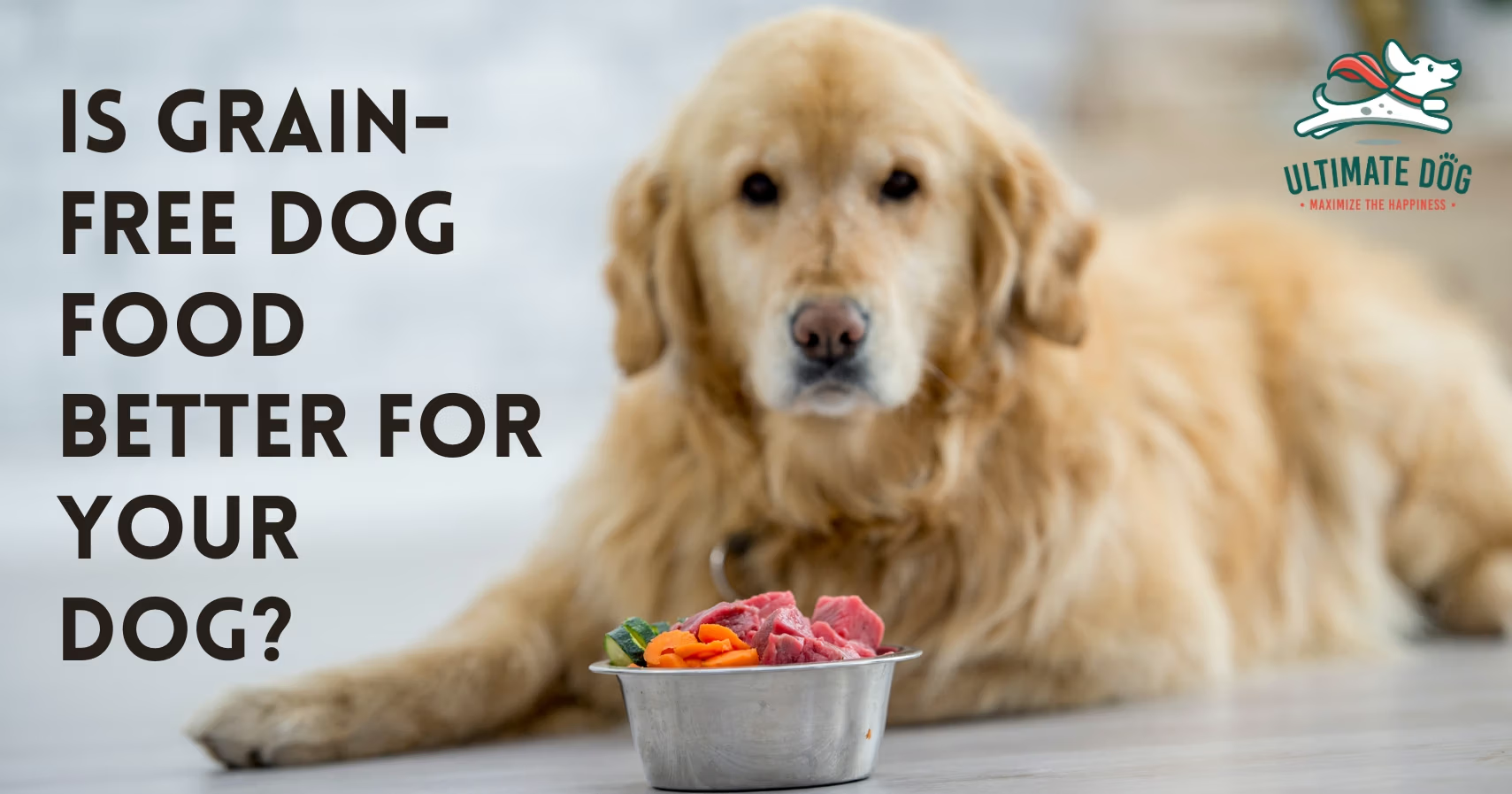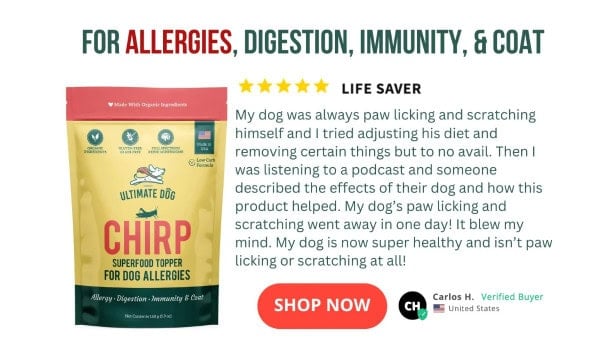|
Getting your Trinity Audio player ready...
|
As an attentive and caring dog owner, you have likely heard the rumor that grain-free diets are unhealthy for dogs. You may have even heard that these foods can cause heart damage. At the same time, you’ve probably listened to us and others in the holistic dog care community rave about the health benefits of excluding grains from your dog’s meals.
So which is it? Are grains good or bad for dogs?
The answer, unsurprisingly, is complicated. In this article, we’ll take an in-depth look at the question of whether grain-free food is good for dogs or not and explore the real problem with most grain-free dog foods.
What Are Grains?
Before we get into whether or not you should feed your dog grains, let’s take a moment to define this term.
Technically speaking, a grain is the edible part of a grass seed. Some of the most common grains used in dog foods include corn, wheat, barley, rice, oats, and millet.
Whole grains contain plenty of starch, fiber, and protein. But most grains used in dog food come in the refined form, meaning the protein and fiber-rich parts have been removed, leaving only low-nutrient starch behind.
Are Grains Bad for Dogs?
The term “bad” is a loaded one. So, let’s look a little deeper.
Yes, dogs can eat grains. Thousands of years of evolving alongside humans have given dogs the unique ability to derive energy from starches like grains in a way that wild canids, like wolves and coyotes, cannot. Some breeds, like those descended from ancestors living in the breadbasket of civilization, are better at this than northern breeds that have historically eaten high meat and seafood diets.
But just because one can digest something doesn’t mean they should eat it. Humans, for instance, can easily digest and gain energy from candy, but it isn’t good for us. Dogs and grains is a similar situation.
Dogs have no nutritional need for grains as they have evolved to get all their energy from fat and protein. Grains, especially refined grains, offer no essential nutrients that dogs can’t get from meat. And grains that do contain key nutrients (unrefined grains) are hard for dogs to digest, and therefore, the nutrients are less likely to be absorbed. So, while dogs can eat grains, they tend to have better health and longevity when they get their nutrients from meat.
This would seem to indicate that grain-free commercial diets are a better choice for your dog than a commercial grain-containing diet. But, as you can guess, it isn’t that simple.
The Real Problem with Grain-Free Dog Food
The problem with commercial grain-free diets isn’t about the missing grains. It’s about what those grains are replaced with.
You see, grains like corn, wheat, and barley are high in starch and low in protein. In order for dog food companies to meet AAFCO standards for protein, manufacturers of these diets have to add a certain amount of meat to their recipes. While lower than any holistic veterinary practitioner would like to see, these amounts are generally high enough to meet most dogs’ basic dietary protein needs.
When dog food manufacturers remove grains from a recipe, they need to replace them with something equally starchy. Why? Because in order to make kibble that doesn’t crumble apart, the recipe needs to contain at least 30% starch. (By the way, this is way more starch than any dog needs in their diet.)
Most grain-free recipes use alternatives like legumes, lentils, and potatoes to fill their starch quota. But these non-grains bring their own set of problems.
Legumes and lentils are naturally high in protein. But unlike protein from meat, these ingredients do not contain a full range of amino acids. Specifically, legumes do not contain taurine.
Taurine is a vital amino acid for heart, brain, muscle, eye, and immune health. Luckily, dogs are able to make their own taurine (unlike cats) using cysteine and methionine. The problem? Legumes and lentils are naturally very low in these two amino acids as well.
Because these plant ingredients are high in overall protein, dog food manufacturers can get away with adding less meat to these recipes. This results in a diet with average to high protein levels but very low levels of certain important amino acids.
Potatoes come with their own set of issues. This starch is not high in protein, which means grain-free foods that contain potatoes instead of legumes typically contain the same amount of meat as grain-based commercial foods. However, potatoes appear to reduce the absorption rate of taurine and other amino acids in a way grains do not.
These starchy tubers are very high in oligosaccharides. This unique type of carbohydrate has been found to increase the amount of primary bile acid excreted in feces. Primary bile acid is very high in taurine. Typically, this taurine would be reabsorbed into the body in the gut, but the fiber and oligosaccharide content of potatoes appears to prevent this process, causing dogs to lose much of their taurine with each bowel movement.
There is also good reason to believe that high-starch foods, like gluten-free diets made of legumes and potatoes, can dramatically affect the gut biome of dogs. Certain gut bacteria are known to absorb the taurine in bile before the dog’s system can take it back. Studies have shown that dogs on high-starch diets are more likely to have high populations of these bacteria in their gut.
DCM and Grain-Free Diets
Dilated cardiomyopathy (DCM) has recently become a hot topic in the dog world. For a long time, the only dog owners who had to worry about this condition were owners of large dog breeds.
Big dogs tend to suffer from DCM more often than other dogs. This is because these big fur balls do not synthesize their own taurine as effectively as smaller dogs. Some specific breeds, such as English Cocker Spaniels, seem to have genetic predispositions that lower their taurine levels. Like big dogs, if these breeds don’t get enough taurine in their diet, the muscles of the heart suffer, and they can develop DCM.
For a long time, this was the norm. So you can imagine how strange it was when vets across the country started diagnosing medium and small-breed dogs with DCM at a much higher rate than ever before. After looking at the data, the FDA released a report highlighting the relationship between grain-free diets and the development of DCM in dogs not typically prone to the condition.
Many took this to mean that dogs need grain in their diets to stay heart-healthy. Of course, this isn’t the case. Grains add no more taurine, cysteine, or methionine to a dog’s body than peas, potatoes, or lentils.
The problem these DCM dogs encountered was not a lack of grains but a lack of quality animal protein and, in some cases, too many oligosaccharides.
Is Grain-Free Kibble Better?
The truth is that the best diets for dogs are free from grains. But that doesn’t mean that all grain-free diets are better than grain-containing diets.
Most commercial grain-free kibble is high in legumes, lentils, and/or potatoes due to necessity—they need those starches in the recipe, or the kibble would fall apart. If these ingredients aren’t adequately offset by a high amount of quality meat ingredients, dogs will struggle to get enough taurine from them.
After the DCM crises, some kibble manufacturers realized they needed to include more taurine in the recipes to negate the issue of too much plant protein. While this is likely to be better than the alternative, lab-made amino acids simply aren’t absorbed and used by the body as well as naturally occurring amino acids.
In fact, a dog food ingredient list that contains a lot of single amino acids is indicative of low-quality food. Manufacturers have to add these amino acids when the proteins they use are low quality. This is true whether it’s a grain-containing diet with substandard animal protein or a grain-free diet with too little meat and too much plant protein.
Now, some responsible dog food manufacturers have started adding more animal protein to their grain-free diets in an attempt to up natural amino acid levels. Unfortunately, this isn’t always enough. And again, this is true for both grain-free and grain-containing diets.
Whenever meat is heat processed, some of the amino acids are broken down and lost. In fact, studies have found that any time meat is heated, taurine levels drop. And since kibble has to be heated during processing, you can assume all dog kibble contains lower quantities of natural taurine than the recipe would indicate.
So, is grain-free kibble better than grain-containing kibble? Some brands of grain-free kibble are better than some brands of grain-containing kibble. But the opposite is also true. So what is the best thing to feed your dog? (Hint: Not kibble.)
How to Feed Grain-Free Right
If grain-free kibble can be just as bad as grain-containing kibble, what should you feed your dog?
The healthiest option is an unprocessed, grain-free diet. These come in various forms, all with their pros and cons.
If easy is what you’re after, then there are some good commercial options in the category of unprocessed and grain-free. Air-dried, freeze-dried, and dehydrated dog food diets are minimally processed and almost always grain-free.
Because these diets aren’t extruded like kibble, they don’t need as much starch, which means they tend to be higher in meat and low-starch fruits and vegetables. Of course, quality varies as with any other commercial product, so always check the ingredients list and be wary of any recipe that uses added amino acids and synthetic nutrients.
Another fairly easy option is to go with a frozen raw commercial diet. These are as close as you can get to homemade raw without doing the work yourself. Frozen raw diets tend to be very high in meat and almost never contain grains. On the downside, they can be pricey and require storage space in the freezer.
Your last option is to prepare your dog’s meals yourself. This gives you full control of what goes into your dog’s body. The best approach is to include plenty of high-quality muscle meat and organ meat, as well as ground bone or egg shells for calcium, and some low-starch, nutrient-dense vegetables and fruits. The addition of quality, natural supplements is also usually advised. These diets are best fed raw, but can be gently cooked if you prefer.
Of course, ensuring proper nutrition when making your dog’s diet at home can be tricky. So be sure to educate yourself and, if you can, work with a canine nutritionist before you make the switch from kibble to raw.
The Final Word on Grain-Free Diets
When it comes to whether grain-free dog food is good or bad, the answer is the same as it is for traditional dog food: It depends on the ingredients.
Grain-free foods that contain high amounts of quality animal protein are good, just like grain-containing dog foods with high amounts of quality animal protein. But if you don’t want to settle for “good” and would rather feed your dog an “excellent” diet, you need to get away from kibble altogether.
Raw dog food in its various forms—air-dried, freeze-dried, dehydrated, frozen, and home-prepared—is going to be better for your pup than any commercial kibble out there. Yes, these diets are typically grain-free, but that isn’t the only thing that makes them better.
Raw diets contain everything your dog needs—including all the important amino acids for heart and overall health—because they contain quality meat ingredients and little to no starch or plant protein.
So if you want to ensure the best nutrition for your dog, forget grains and focus on high-quality, fresh meat ingredients.
Sources
Adin, D., Freeman, L., Stepien, R., Rush, J. E., Tjostheim, S., Kellihan, H., Aherne, M., Vereb, M., & Goldberg, R. (2021). Effect of type of diet on blood and plasma taurine concentrations, cardiac biomarkers, and echocardiograms in 4 dog breeds. Journal of Veterinary Internal Medicine, 35(2), 771–779.
Axelsson, E., Ratnakumar, A., Arendt, M., Maqbool, K., Webster, M. T., Perloski, M., Liberg, O., Arnemo, J. M., Hedhammar, Å., & Lindblad-Toh, K. (2013). The genomic signature of dog domestication reveals adaptation to a starch-rich diet. Nature, 495(7441), 360–364.
Case, L. P. (2018). DCM in Dogs: Taurine’s Role in the Canine Diet.Whole Dog Journal. Retrieved October 23, 2024
Pezzali, J. G., Acuff, H. L., Henry, W., Alexander, C., Swanson, K. S., & Aldrich, C. G. (2020). Effects of different carbohydrate sources on taurine status in healthy Beagle dogs. Journal of Animal Science, 98(2).
Shabbir, M. A., Raza, A., Anjum, F. M., Khan, M. R., & Suleria, H. a. R. (2013). Effect of Thermal Treatment on Meat Proteins with Special Reference to Heterocyclic Aromatic Amines (HAAs). Critical Reviews in Food Science and Nutrition, 55(1), 82–93.

Sara Seitz worked in the pet industry for over a decade. In addition to being a certified dog trainer, Sara gained experience working as the general manager of a dog daycare and boarding facility, as the creator and manager of a pet sitting company, as a groomer, and as a dog behavior evaluator. She also has a bachelors in animal behavior from CSU. Currently, Sara works as a freelance writer specializing in blog, article and content writing.





Leave a Comment